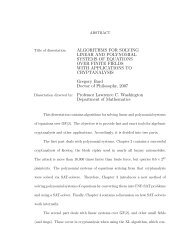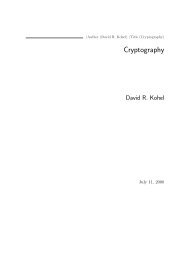SAGE: Software for Algebra and Geometry ... - William Stein
SAGE: Software for Algebra and Geometry ... - William Stein
SAGE: Software for Algebra and Geometry ... - William Stein
- No tags were found...
You also want an ePaper? Increase the reach of your titles
YUMPU automatically turns print PDFs into web optimized ePapers that Google loves.
<strong>SAGE</strong>: <strong>Software</strong> <strong>for</strong> <strong>Algebra</strong> <strong>and</strong> <strong>Geometry</strong>Experimentation<strong>William</strong> <strong>Stein</strong>April 29, 2006: SFSU AMS Meeting<strong>William</strong> <strong>Stein</strong><strong>SAGE</strong>: <strong>Software</strong> <strong>for</strong> <strong>Algebra</strong> <strong>and</strong> <strong>Geometry</strong> Experimentation
What is <strong>SAGE</strong>?I started <strong>SAGE</strong> last year, <strong>and</strong> it has since mushroomed. There arenow dozens of contributors all over the world <strong>and</strong> an extremelyactive mailing list.1. Completely free <strong>and</strong> open source.2. A new computer algebra system: Uses a mainstreamlanguage (unlike Magma, Gap, Mathematica, Maple, etc.)3. A new way to use your software: use all your favorite(commercial or free) mathematics software together.<strong>William</strong> <strong>Stein</strong><strong>SAGE</strong>: <strong>Software</strong> <strong>for</strong> <strong>Algebra</strong> <strong>and</strong> <strong>Geometry</strong> Experimentation
Does Open Source Matter <strong>for</strong> Math Research?“You can read Sylow’s Theorem <strong>and</strong> its proof in Huppert’s book in thelibrary [...] then you can use Sylow’s Theorem <strong>for</strong> the rest of your life freeof charge, but <strong>for</strong> many computer algebra systems license fees have to bepaid regularly [...]. You press buttons <strong>and</strong> you get answers in the sameway as you get the bright pictures from your television set but you cannotcontrol how they were made in either case.With this situation two of the most basic rules of conduct inmathematics are violated: In mathematics in<strong>for</strong>mation is passed onfree of charge <strong>and</strong> everything is laid open <strong>for</strong> checking. Not applyingthese rules to computer algebra systems that are made <strong>for</strong> mathematicalresearch [...] means moving in a most undesirable direction. Mostimportant: Can we expect somebody to believe a result of a programthat he is not allowed to see? ”– J. Neubüser in 1993 (he started GAP in 1986).<strong>William</strong> <strong>Stein</strong><strong>SAGE</strong>: <strong>Software</strong> <strong>for</strong> <strong>Algebra</strong> <strong>and</strong> <strong>Geometry</strong> Experimentation
<strong>SAGE</strong>: A New Computer <strong>Algebra</strong> Systemalgebras edu interfaces modular schemescategories ext lfunctions modules setscoding functions libs monoids structurecrypto geometry matrix plot testsdatabases groups misc rings$ cat */*.py */*/*.py */*/*/*.py */*.pyx */*/*.pyx |sort|un58858$ cat */*.py */*/*.py */*.pyx */*/*.pyx |sort|uniq|grep "sa6845
Cooperation: “Everything Under One Roof”<strong>SAGE</strong> has many interfaces (bold included with <strong>SAGE</strong>):◮ GAP (started 1986)– groups, discrete math◮ Singular (started 1987) – polynomial computation◮ PARI/GP (started 1987) – number theory◮ Maxima (started 1967) – symbolic manipulation◮ mwrank, ec, simon, sea – elliptic curves◮ Macaulay2 (started 1993) – (soon to be included)◮ KANT/KASH – sophisticated algebraic number theory◮ Magma (started 1973) – high-quality research mathenvironment◮ Maple – symbolic, educational◮ Mathematica – symbolic, numerical, educational◮ Octave (started 1992) – numerical analysis◮ Specialized: mwrank, gfan, sympow, ntl, genus2reduction,polymake, lcalc (Rubinstein), dokchitser; more to come...!<strong>William</strong> <strong>Stein</strong><strong>SAGE</strong>: <strong>Software</strong> <strong>for</strong> <strong>Algebra</strong> <strong>and</strong> <strong>Geometry</strong> Experimentation
Python: A Mainstream Programming Language◮ Guido van Rossum released first Python in 1991.◮ A “gluing language”, i.e., design to be easier to use libraries<strong>and</strong> other programs.◮ VAST range of libraries: graphics, 3d simulation, webprogramming, numerical analysis, etc.◮ Easy to read code◮ function? gives documentation about function <strong>and</strong>function?? gives the source code.◮ IPython: Awesome!<strong>William</strong> <strong>Stein</strong><strong>SAGE</strong>: <strong>Software</strong> <strong>for</strong> <strong>Algebra</strong> <strong>and</strong> <strong>Geometry</strong> Experimentation
Pyrex: Compiled Python-like language1. Written by Greg Ewing of New Zeal<strong>and</strong>.2. Code converted to C code that is compiled by a C compiler.3. Easy to use C/C++ code <strong>and</strong> libraries from Pyrex.4. Time-critical <strong>SAGE</strong> code gets implemented in Pyrex, whichis (as fast as) C code, but easier to read (e.g., since allvariables <strong>and</strong> scopes are explicit).<strong>William</strong> <strong>Stein</strong><strong>SAGE</strong>: <strong>Software</strong> <strong>for</strong> <strong>Algebra</strong> <strong>and</strong> <strong>Geometry</strong> Experimentation
Examples! Examples! Examples!sage: E = EllipticCurve(’681b’); EElliptic Curve defined byy^2 + x*y = x^3 + x^2 - 1154*x - 15345 ...sage: E.analytic_rank()0sage: E.sha_an()9sage: E.non_surjective()[(2, ’2-torsion’)]sage: E.heegner_discriminants_list(10)[-8, -20, -35, -56, -68, -83, -95, -107, -119, -143]sage: n = E.heegner_index(-20); n[8.99999215656, 9.00000831615]sage: parent(n)Float interval arithmetic pseudoring.sage: n^2 + 10[90.9998588182, 91.0001496907]<strong>William</strong> <strong>Stein</strong><strong>SAGE</strong>: <strong>Software</strong> <strong>for</strong> <strong>Algebra</strong> <strong>and</strong> <strong>Geometry</strong> Experimentation
L-functionssage: E = EllipticCurve(’681b’)sage: L = E.Lseries_dokchitser() # T. Dokchitsersage: L(1)1.8448152061268208sage: L(2)1.1760028810441643sage: L(1+I)0.28769581060576460 - 0.59781383500693885*Isage: E.Lseries_zeros(5) # M. Rubinstein[1.1931974371, 2.9775032355, 4.1340673324, 5.1249133553, 5.sage: E.Lseries_sympow(2,16) # M. Watkins’1.010475324678458E+00’<strong>William</strong> <strong>Stein</strong><strong>SAGE</strong>: <strong>Software</strong> <strong>for</strong> <strong>Algebra</strong> <strong>and</strong> <strong>Geometry</strong> Experimentation
Image of a line segment under L(E, s)sage: E = EllipticCurve(’37a’)sage: v = E.Lseries_values_along_line(1, 1+10*I, 300)sage: w = [(z[1].real(), z[1].imag()) <strong>for</strong> z in v]sage: L = line(w, rgbcolor=(0.5,0,0))sage: L.save(’line.png’)<strong>William</strong> <strong>Stein</strong><strong>SAGE</strong>: <strong>Software</strong> <strong>for</strong> <strong>Algebra</strong> <strong>and</strong> <strong>Geometry</strong> Experimentation
Graphing a Complex L-seriessage: E = EllipticCurve(’389a’)sage: L = E.Lseries_dokchitser()sage: L(1+I)-0.63840993858803874 + 0.71549523920466740*Isage: L(1+0.2*I, 50)-0.030658879217008016 + 0.0035873942766903410*I<strong>William</strong> <strong>Stein</strong><strong>SAGE</strong>: <strong>Software</strong> <strong>for</strong> <strong>Algebra</strong> <strong>and</strong> <strong>Geometry</strong> Experimentation
Arithmetic of our favorite rank 1 curvesage: E = EllipticCurve(’37a’)sage: E.sha_an() --> 1sage: E.non_surjective() --> []sage: E.sha_an() --> 1sage: E.regulator() --> 0.051111408239999996sage: E.gens() --> [(0 : 0 : 1)]sage: E.heegner_discriminants(50) --> [-3, -4, -7, -11, -4sage: E.heegner_index(-7) # Kolyvagin ==> Sha trivial[0.999990645298, 1.00000935475]sage: E.q_expansion(5)--> q - 2*q^2 - 3*q^3 + 2*q^4 + O(q^5)sage: E.simon_two_descent ()(1, 1, [(0 : 108 : 1)])sage: E.sea(next_prime(10^50))100000000000000000000000001917684156174529696959920<strong>William</strong> <strong>Stein</strong><strong>SAGE</strong>: <strong>Software</strong> <strong>for</strong> <strong>Algebra</strong> <strong>and</strong> <strong>Geometry</strong> Experimentation
Saving <strong>and</strong> Loading ObjectsMost objects in <strong>SAGE</strong> can easily be loaded <strong>and</strong> saved in acompressed <strong>for</strong>mat. (This is a st<strong>and</strong>ard feature of Python!)sage: M = ModularSymbols(Gamma1(13),2); MFull Modular Symbols space <strong>for</strong> Gamma_1(13) ...dimension 15.sage: D = M.decomposition(3)sage: [A.dimension() <strong>for</strong> A in D][1, 1, 1, 2, 2, 2, 2, 4]sage: save(M, ’modsym13’)... ...sage: M = load(’modsym13’)sage: D = M.decomposition(3) # instant!sage: D[-1].hecke_operator(2).charpoly().factor()(x^2 + 3*x + 3)^2<strong>William</strong> <strong>Stein</strong><strong>SAGE</strong>: <strong>Software</strong> <strong>for</strong> <strong>Algebra</strong> <strong>and</strong> <strong>Geometry</strong> Experimentation
<strong>SAGE</strong> is not only <strong>for</strong> number theory!sage: P. = ProjectiveSpace(3,QQ)sage: C = P.subscheme([y^2-x*z, z^2-y*w, x*w-y*z])sage: len(C.irreducible_components()) # twisted cubic1sage: J = C.defining_ideal()sage: G = J.groebner_fan()sage: len(G.reduced_groebner_bases())8sage: G.fvector()(1, 8, 8)sage: f = prod(J.gens()) # \/-- newton polytopesage: NP = polymake.convex_hull(f.exponents())sage: NP.facets()[(3/2, 5/2, -1, 0), (3, 1, -1, 0), (1, 0, 0, 0),(-3/2, 2, 1, 0), (3, -1, 4, 0), (-3, 1, 5, 0)](And <strong>Stein</strong> is not only a number theorist anymore...)<strong>William</strong> <strong>Stein</strong><strong>SAGE</strong>: <strong>Software</strong> <strong>for</strong> <strong>Algebra</strong> <strong>and</strong> <strong>Geometry</strong> Experimentation
<strong>SAGE</strong>: A Future?◮ August 2006: MSRI grad student Workshop on Computingwith Modular Forms (with <strong>SAGE</strong>).◮ October 2006: <strong>SAGE</strong> Days 2 in Seattle.◮ UW startup money: Very generous financial support <strong>for</strong> <strong>SAGE</strong>development (hiring a team of students, mainly undergrads).◮ Most <strong>SAGE</strong> users are coauthors/developers of <strong>SAGE</strong>.<strong>William</strong> <strong>Stein</strong><strong>SAGE</strong>: <strong>Software</strong> <strong>for</strong> <strong>Algebra</strong> <strong>and</strong> <strong>Geometry</strong> Experimentation
















